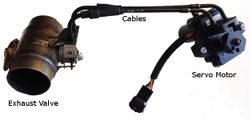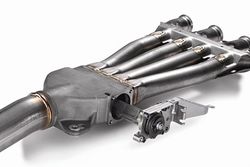Exhaust Ultimate Power Valve
A variable valve system that eliminates “valleys” in the torque development curve in 4-stroke engines. With continual improvement since the first adoption on the ’87 model FZR400R, the latest version is used on the YZF-R1.
In this system a variable EXUP valve is placed in the muffler that functions in accordance with engine rpm to control the reflection wave cycle in the muffler. It was developed to help optimize the exhaust flow in the exhaust valve area in a way that makes the exhaust as well as the intake function more efficient and reduces power loss due to the “blow-back” phenomenon. It is a device that in effect creates an adjustable valve that changes the cross-section shape of the interior of the muffler depending on engine rpm to improve performance.
An exhaust servo motor is one component of the exhaust valve system (sometimes called the ex-up or power valve system) found on almost every modern sportbike including all Honda, Kawasaki, Yamaha, Suzuki, BMW, Ducati, Triumph and a few others. The system consist of a few parts, the first is the valve assembly inside the exhaust pipe. This is a simple butterfly valve that can open or close to change the amount of exhaust flow. Connected to this valve is a set of cables that run to the other part of the system, the servo motor. This motor, which is controlled by the engine control unit, has a pulley on top that rotates the cables to open and close the valve in the exhaust. The cables are used to isolate the motor from the hot exhaust and allow it to be placed in a more convenient place on the bike.
The purpose of this system according to the motorcycle manufacturers’ marketing departments is to create back-pressure at lower RPM’s to increase torque. Unfortunately, this probably isn’t the real reason; the true purpose of the exup valves is to meet noise and emissions regulations. The exhaust valves are partially closed at idle and low rpm to reduce noise, and closed again at the upper RPMs to meet peak noise and emissions regulations. The proof of this has been shown on the dyno where removing the valves and retuning the engine creates a flatter better torque curve. Additionally, in the USA, most bikes close the valve again at the upper RPM range, but in Europe they do not (different regulations) and the European bikes typically create a few more HP on the top end as a result.
Effect
- Realizes elimination of low torque in certain rpm ranges and smooth acceleration all the way up to high speed.
- Improved actual fuel economy.
- Improved low-speed range combustion for
- more stable idling,
- less idling noise and
- reduced HC levels in the exhaust.

